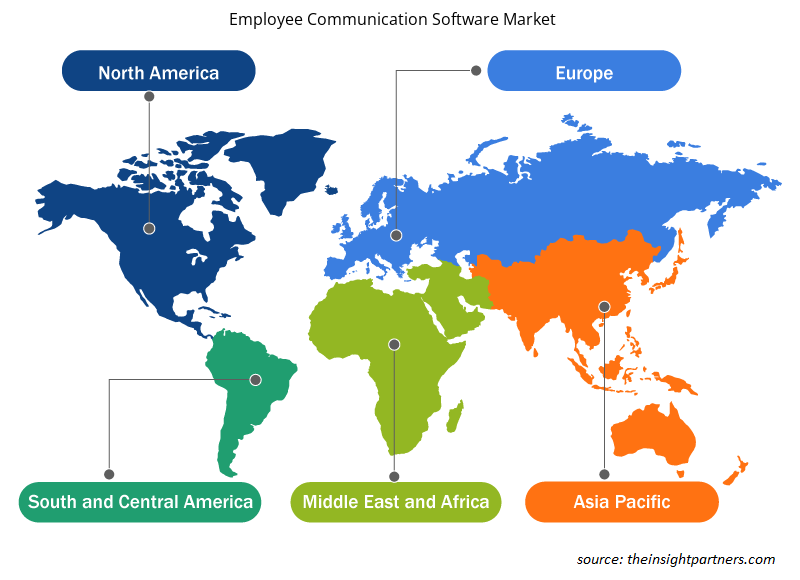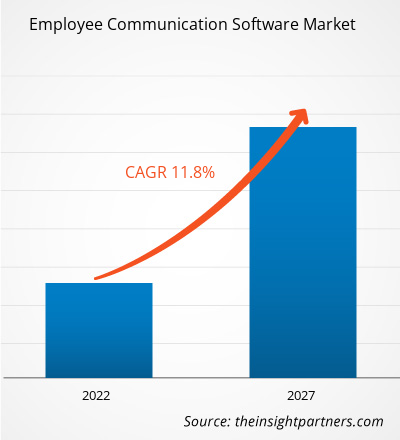Der Markt für Mitarbeiterkommunikationssoftware soll von 816,41 Millionen US-Dollar im Jahr 2021 auf 1.780,09 Millionen US-Dollar im Jahr 2027 wachsen. Im Prognosezeitraum 2021 bis 2027 wird für den Markt für Mitarbeiterkommunikationssoftware eine durchschnittliche jährliche Wachstumsrate (CAGR) von 11,8 % erwartet.
Mit zunehmender Wettbewerbsfähigkeit in allen Branchen wächst in Unternehmen der Bedarf an hoher Betriebs- und Mitarbeiterproduktivität für nachhaltiges und profitables langfristiges Wachstum. Daher steigt die Nachfrage nach effizienten und effektiven Lösungen für die Mitarbeiterkommunikation in Branchen wie BFSI, Fertigung, Einzelhandel, Gesundheitswesen, IT und Telekommunikation, Bildung und anderen in beeindruckendem Tempo. Die interne Unternehmenskommunikation spielt eine entscheidende Rolle bei der Förderung von Zusammenarbeit, Produktivität und Mitarbeiterengagement in einem Unternehmen. Darüber hinaus sind die entscheidende Notwendigkeit, eine angemessene Kommunikation mit Mitarbeitern ohne Schreibtisch aufrechtzuerhalten, und der wachsende Anteil von Remote-Mitarbeitern aufgrund des anhaltenden Coronavirus-Ausbruchs einige der wichtigen Faktoren, die die Einführung von Software und Diensten für die Mitarbeiterkommunikation weltweit fördern. Es gibt mehrere innovative Unternehmen, die diese Lösungen mit einer Vielzahl integrierter Funktionen anbieten. Eine Mitarbeiterkommunikationssoftware ermöglicht es Unternehmen, abteilungsübergreifende Kommunikation anzupassen und gezielte Kommunikation anzubieten, beispielsweise interne Kommunikation, HR-Kommunikation, Betriebsnachrichten, Compliance-Kommunikation und Notfallbenachrichtigungen. Diese Lösungen bieten auch ein hohes Maß an Personalisierungs- und Mitarbeiterengagement-Tools, um eine ganzheitliche Kommunikationsentwicklung im gesamten Unternehmen zu unterstützen. Der zunehmende Trend zur Digitalisierung, die wachsende Nachfrage nach ergebnisorientierten Kommunikationslösungen und die zunehmende Einführung Cloud-basierter Lösungen in kleinen, mittleren und großen Unternehmen sind einige der wichtigsten Antriebsfaktoren für das Wachstum des Marktes für Mitarbeiterkommunikationssoftware.
Der Markt für Mitarbeiterkommunikationssoftware ist nach Bereitstellungstyp, Unternehmensgröße, Branche und Geografie segmentiert. Basierend auf dem Bereitstellungstyp ist der Markt für Mitarbeiterkommunikationssoftware in Cloud und On-Premise unterteilt. Das Cloud-Segment wird im Prognosezeitraum von 2021 bis 2027 voraussichtlich das größte und am schnellsten wachsende Segment sein. Auf der Grundlage der Unternehmensgröße ist der Markt in KMU und Großunternehmen segmentiert. Das Segment der Großunternehmen trug 2019 den größten Umsatzanteil bei, während das KMU-Segment voraussichtlich der am schnellsten wachsende Sektor in Bezug auf die Wachstumsrate sein wird. Auf Branchenbasis ist der Markt in BFSI, Fertigung, Einzelhandel, Gesundheitswesen, IT und Telekommunikation und andere segmentiert. Im Jahr 2020 führten die IT- und Telekommunikationsbranche den Markt für Mitarbeiterkommunikationssoftware weltweit an. Geografisch ist der Markt in fünf Hauptregionen segmentiert, nämlich Nordamerika, Europa, APAC, MEA und SAM. Im Jahr 2019 hatte Nordamerika den größten Umsatzanteil, gefolgt von Europa und APAC.
Passen Sie diesen Bericht Ihren Anforderungen an
Sie erhalten kostenlose Anpassungen an jedem Bericht, einschließlich Teilen dieses Berichts oder einer Analyse auf Länderebene, eines Excel-Datenpakets sowie tolle Angebote und Rabatte für Start-ups und Universitäten.
- Holen Sie sich die wichtigsten Markttrends aus diesem Bericht.Dieses KOSTENLOSE Beispiel umfasst eine Datenanalyse von Markttrends bis hin zu Schätzungen und Prognosen.
Markteinblicke für Mitarbeiterkommunikationssoftware
Steigender Bedarf an verbesserter Kommunikation mit Mitarbeitern ohne Schreibtisch, um die Nachfrage anzukurbeln
Angesichts des zunehmenden Wettbewerbs und der sich branchenübergreifend verändernden Technologielandschaft sind Unternehmen kontinuierlich auf der Suche nach Lösungen, die dazu beitragen können, die Mitarbeiterproduktivität, die Betriebseffizienz und das Endbenutzererlebnis zu verbessern und gleichzeitig ihre Gesamtkosten zu senken. Darüber hinaus stellen Unternehmen aufgrund des Coronavirus-Ausbruchs auf eine Telearbeitskultur um, da in verschiedenen Ländern Beschränkungen für Geschäftsaktivitäten vor Ort und Bewegungseinschränkungen eingeführt wurden. Die Struktur moderner Unternehmen wird dynamischer und komplexer, insbesondere in Branchen wie dem Einzelhandel und dem Gesundheitswesen, in denen ein großer Teil der Belegschaft ohne Schreibtisch bzw. mobil arbeitet. Der Ausbruch des Coronavirus treibt den Trend zur Telearbeit auch in anderen Branchen weiter voran, beispielsweise in den Bereichen Finanzdienstleistungen, Fertigung, IT und Telekommunikation. Aufgrund des steigenden Anteils von Belegschaften ohne Schreibtisch in allen Branchen wird erwartet, dass die Nachfrage nach plattformübergreifenden Kommunikationstools (Desktop, Mobilgeräte, Tablets usw.) in den kommenden Jahren beeindruckend steigen wird.
Bereitstellungstyp-basierte Markteinblicke
Basierend auf dem Bereitstellungstyp ist der globale Markt für Mitarbeiterkommunikationssoftware in Cloud und On-Premise segmentiert. Die Nachfrage nach cloudbasierter Mitarbeiterkommunikationssoftware ist größer als nach On-Premise-Mitarbeiterkommunikationssoftware. Die Cloud-basierten Softwareangebote sind günstiger als die On-Premise-Software; außerdem unterstützt eine starke Netzwerkinfrastruktur in Industrieländern auch die Einführung von Cloud-basierter Software. Verschiedene Unternehmen planen erhebliche Investitionen in fortschrittliche Software, um schnell auf moderne Plattformen mit integrierten fortschrittlichen Funktionen umzusteigen.
Markteinblicke basierend auf der Unternehmensgröße
Basierend auf der Unternehmensgröße ist der Markt für Mitarbeiterkommunikationssoftware in KMU und Großunternehmen segmentiert. Das Segment der Großunternehmen ist mit dem größten Anteil führend auf dem Markt für Mitarbeiterkommunikationssoftware.
Branchenbasierte Markteinblicke
Das Endbenutzersegment ist in BFSI, Fertigung, Einzelhandel, Gesundheitswesen, IT und Telekommunikation sowie andere Branchen unterteilt. Das Segment „Sonstige“ umfasst Branchen wie Transport, Regierung, Bildung und Energie usw.
Akteure auf dem Markt für Mitarbeiterkommunikationssoftware konzentrieren sich auf Strategien wie Marktinitiativen, Akquisitionen und Produkteinführungen, um ihre Position auf dem Markt für Mitarbeiterkommunikationssoftware zu behaupten. Einige Entwicklungen der wichtigsten Akteure auf dem Markt für Mitarbeiterkommunikationssoftware sind:
Im September 2020 brachte Smarp Oy eine KI-gestützte Analysesuite auf den Markt. Diese Suite kombiniert KI und Echtzeitanalysen, um die Auswirkungen der Mitarbeiterkommunikation zu messen.
Im April 2020 hat die Nudge Corporation eine Reihe von Funktionen zur Aktivierung der Frontline eingeführt, die darauf abzielen, inaktive Frontline-Mitarbeiter zu aktivieren. Nudge hilft bei der Bewältigung von vier wichtigen Wiederherstellungsphasen, darunter Außendienstausführung, Rekrutierung, Onboarding und nachhaltige Leistung, die bestehende Benchmarks für das Engagement der Mitarbeiter verbessern.
Regionale Einblicke in den Markt für Mitarbeiterkommunikationssoftware
Die regionalen Trends und Faktoren, die den Markt für Mitarbeiterkommunikationssoftware während des gesamten Prognosezeitraums beeinflussen, wurden von den Analysten von Insight Partners ausführlich erläutert. In diesem Abschnitt werden auch die Marktsegmente und die Geografie von Mitarbeiterkommunikationssoftware in Nordamerika, Europa, im asiatisch-pazifischen Raum, im Nahen Osten und Afrika sowie in Süd- und Mittelamerika erörtert.

- Erhalten Sie regionale Daten zum Markt für Mitarbeiterkommunikationssoftware
Umfang des Marktberichts zur Mitarbeiterkommunikationssoftware
| Berichtsattribut | Details |
|---|---|
| Marktgröße im Jahr 2021 | 816,41 Millionen US-Dollar |
| Marktgröße bis 2027 | 1.780,09 Millionen US-Dollar |
| Globale CAGR (2021 - 2027) | 11,8 % |
| Historische Daten | 2019-2020 |
| Prognosezeitraum | 2022–2027 |
| Abgedeckte Segmente | Nach Bereitstellungstyp
|
| Abgedeckte Regionen und Länder | Nordamerika
|
| Marktführer und wichtige Unternehmensprofile |
|
Marktteilnehmerdichte: Der Einfluss auf die Geschäftsdynamik
Der Markt für Mitarbeiterkommunikationssoftware wächst rasant, angetrieben durch die steigende Nachfrage der Endnutzer aufgrund von Faktoren wie sich entwickelnden Verbraucherpräferenzen, technologischen Fortschritten und einem größeren Bewusstsein für die Vorteile des Produkts. Mit steigender Nachfrage erweitern Unternehmen ihr Angebot, entwickeln Innovationen, um die Bedürfnisse der Verbraucher zu erfüllen, und nutzen neue Trends, was das Marktwachstum weiter ankurbelt.
Die Marktteilnehmerdichte bezieht sich auf die Verteilung der Firmen oder Unternehmen, die in einem bestimmten Markt oder einer bestimmten Branche tätig sind. Sie gibt an, wie viele Wettbewerber (Marktteilnehmer) in einem bestimmten Marktraum im Verhältnis zu seiner Größe oder seinem gesamten Marktwert präsent sind.
Die wichtigsten Unternehmen auf dem Markt für Mitarbeiterkommunikationssoftware sind:
- Beekeeper AG
- Nudge Corporation
- Poppulo (E-Search DAC)
- Simpplr Inc.
- Smarp Oy
Haftungsausschluss : Die oben aufgeführten Unternehmen sind nicht in einer bestimmten Reihenfolge aufgeführt.

- Überblick über die wichtigsten Akteure auf dem Markt für Mitarbeiterkommunikationssoftware
Markt für Mitarbeiterkommunikationssoftware – nach Bereitstellungstyp
- Wolke
- Vor Ort
Markt für Mitarbeiterkommunikationssoftware – nach Unternehmensgröße
- KMU
- Große Unternehmen
Markt für Mitarbeiterkommunikationssoftware – nach Branchen
- BFSI
- Herstellung
- Einzelhandel
- Gesundheitspflege
- IT und Telekommunikation
- Weitere Branchen
Markt für Mitarbeiterkommunikationssoftware – nach Geografie
- Nordamerika
- UNS
- Kanada
- Mexiko
- Europa
- Frankreich
- Deutschland
- Russland
- Vereinigtes Königreich
- Italien
- Restliches Europa
- Asien-Pazifik (APAC)
- China
- Indien
- Japan
- Australien
- Südkorea
- Restlicher Asien-Pazifik-Raum
- MEA
- Saudi-Arabien
- Vereinigte Arabische Emirate
- Südafrika
- Rest von MEA
- SAM
- Brasilien
- Argentinien
- Rest von SAM
Markt für Mitarbeiterkommunikationssoftware – Firmenprofile
- Beekeeper AG
- Nudge Corporation
- Poppulo (E-Search DAC)
- Simpplr Inc.
- Smarp Oy
- SnapComms
- Sociabble, Inc.
- Mitarbeiterbasis
- dieEMPLOYEEapp
- Workvivo Limited
- Historische Analyse (2 Jahre), Basisjahr, Prognose (7 Jahre) mit CAGR
- PEST- und SWOT-Analyse
- Marktgröße Wert/Volumen – Global, Regional, Land
- Branchen- und Wettbewerbslandschaft
- Excel-Datensatz
Aktuelle Berichte
Verwandte Berichte
Erfahrungsberichte
Grund zum Kauf
- Fundierte Entscheidungsfindung
- Marktdynamik verstehen
- Wettbewerbsanalyse
- Kundeneinblicke
- Marktprognosen
- Risikominimierung
- Strategische Planung
- Investitionsbegründung
- Identifizierung neuer Märkte
- Verbesserung von Marketingstrategien
- Steigerung der Betriebseffizienz
- Anpassung an regulatorische Trends





















 Kostenlose Probe anfordern für - Markt für Mitarbeiterkommunikationssoftware
Kostenlose Probe anfordern für - Markt für Mitarbeiterkommunikationssoftware